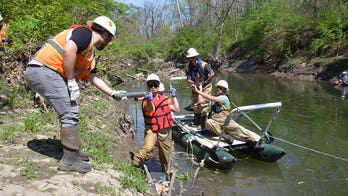
At left, President Richard Nixon is shown in the Oval Office in Oct. 13, 1973; at right, Eugenio R. Martinez, a CIA mole involved in the Watergate break-in. (AP)
EXCLUSIVE: An internal history of the Watergate scandal prepared by the Central Intelligence Agency – intended to help the Agency make a clean breast of its own wrongdoing and kept in classified vaults for more than four decades – reveals how the spy service used a double agent to keep tabs on the burglars whose arrests ultimately led to the resignation of President Richard Nixon, and withheld information about the agent from federal prosecutors.
Entitled “Working Draft – CIA Watergate History,” the 155-page study was largely written by John C. Richards, a CIA officer who died in December 1974, and was brought nearly to completion by unnamed Agency colleagues who built on Richards’ typed draft and handwritten annotations.
Earlier this year, a federal judge ordered the government to turn the document over to Judicial Watch, the conservative legal watchdog, which had sued for access under the Freedom of Information Act. The group finally received the declassified report in July and shared it with Fox News.
Even in draft form, the document represents CIA’s fullest narrative treatment of the Watergate affair, which first surfaced publicly in the predawn hours of June 17, 1972. That’s when Washington police, dressed in plain clothes and responding to a call from a private security guard, arrested at gunpoint five burglars inside the Democratic National Committee headquarters at the Watergate office complex in Washington.
The arrested men were wearing business suits and rubber gloves and carrying electronic eavesdropping devices. Investigation swiftly revealed that one of them was employed by the president's re-election campaign committee, and that four of the five boasted past ties to CIA. But one of the arrested men, it turns out, was still on Langley's payroll at the time of the arrests, and had been feeding information about the break-in team to his CIA case officers the entire time.
That CIA mole was Eugenio R. Martinez, a Cuban Bay of Pigs veteran who was recruited to the break-in team by E. Howard Hunt, the legendary former CIA officer and spy novelist who had helped plan the Bay of Pigs operation in the Kennedy era and had gone on to work as a consultant on covert projects at the Nixon White House. Along with re-election committee lawyer G. Gordon Liddy, a former FBI agent, Hunt masterminded the doomed break-in and surveillance operation at the DNC; he and Liddy would be indicted along with the five arrested men and both would serve lengthy sentences in federal prison.
While Watergate scholars have previously reported that Martinez was a CIA informant during the time he was working for Hunt and Liddy – the wiry operative known as "Musculito" provided Langley with a steady stream of information about the Cuban exile community in Miami, from where he and three of the other burglars hailed, for $100 a month (about $575 today) – the newly declassified CIA document fleshes out the relationship in greater detail and shows how highly the Agency prized it.
In October 1973 – by which point the months-long effort of the Nixon White House to cover up the origins of the DNC break-in had collapsed, and President Nixon was struggling in vain to stave off impeachment – attorneys from the Watergate Special Prosecution Force met with the CIA’s top lawyer and sought access to documents concerning Martinez. In particular, the draft report states, the WSPF lawyers wanted to review a previous report prepared by one of Martinez’s case officers in Miami and a copy of Martinez’s “roundup of his discussions with Hunt” from April 1972, the month before the burglars first penetrated the DNC suite.
CIA General Counsel John S. Warner adamantly refused. “Warner stated that under no circumstances would the Agency give up all records relating to the Agency’s relationship with Martinez,” the report stated. “Warner explained why such a request was difficult for the Agency – the breaching of trust of an agent.”
The document marks the first known reference by CIA to Martinez as “an agent,” as opposed to an informant, and exposes how valuable an asset the Agency considered him to be. Among several-dozen passages of the report still redacted today, more than four decades after the events in question, are the names of two CIA case officers to whom Martinez reported.
Elsewhere the report chronicles how top CIA officials, including then-Director Richard Helms, withheld data about Martinez from the FBI at the very outset of its investigation of the break-in.
On June 19, 1972, the first business day after the burglars were arrested, the report notes that Helms received a briefing from CIA’s Director of Security at the time, Howard Osborn, who provided “biographic details” for each of the arrested men. Yet three days later, the report states, Helms told the Bureau's acting director, L. Patrick Gray III, that “none [of the arrested men] had worked for the Agency in the past two years.” That was untrue where Martinez was concerned.
"This CIA Watergate report is an extraordinary historical document," said Judicial Watch President Tom Fitton in a statement to Fox News. "Given that it disclosed direct CIA involvement in Watergate, it is no surprise it took forty-two years and a Judicial Watch lawsuit to force its release."
Now 94 and believed to be living in Miami, Martinez has granted virtually no interviews. He has long fascinated Watergate scholars, both because of his dual role on the break-in team and because the FBI determined that a key that Martinez was carrying at the time of the arrests -- and struggled unsuccessfully to conceal from the police -- fit the desk of DNC secretary Ida “Maxie” Wells, whose telephone was the only one wiretapped in the ill-fated operation. No other burglar had such a key and it has never been satisfactorily explained as to how or why Martinez came into possession of it.
Jim Hougan, author of Secret Agenda: Watergate, Deep Throat and the CIA, a landmark study of the break-in published by Random House in 1984, called the declassified draft “an artifact in its own right” but said it carries “a musty fragrance, brought on by having been squirreled away for so long that its narrative has begun to rot.”
Hougan pointed to numerous aspects of Watergate – all of which involved CIA – that are unmentioned in the Agency’s ostensibly comprehensive mea culpa. These omissions include, among other things, the destruction of Watergate-related documents shortly after the arrests by a CIA officer named Lee Pennington and the activities of Robert F. Bennett, later a U.S. senator from Utah, who as a CIA asset in the early 1970s sent his superiors a memorandum – first published in Hougan’s book – boasting of how he had been feeding Bob Woodward of the Washington Post story leads that led him and the newspaper away from Agency involvement in Watergate. For this, Bennett said in the 1973 memorandum, the reporter was “suitably grateful for the fine stories and by-lines which he gets.”
One area where the CIA draft report appears willfully to have steered clear of further implicating the Agency was in its reference to a CIA officer named Rob Roy Ratliff, the Agency’s liaison on the National Security Council.
In a 1974 affidavit filed with the House Judiciary Committee when it was weighing articles of impeachment against President Nixon, Ratliff swore that E. Howard Hunt, while ostensibly retired from CIA and working as a consultant in the Nixon White House, was using secure Agency couriers to send sealed pouches to CIA Director Helms on a regular basis, continuing right up until shortly before the Watergate arrests.
Sources familiar with the matter said the pouches contained “gossip” of a sexually graphic nature about White House officials that could be used for the purpose of constructing psychological profiles of them – a violation of the Agency’s charter. Hunt had already played a lead role in getting CIA prepare such a profile of Daniel Ellsberg, the former Defense Department analyst who leaked the Pentagon Papers to the New York Times.
The draft report mentions Ratliff by name and notes the existence of his affidavit – but otherwise makes no mention of its explosive contents, which suggested that Hunt had never really retired from CIA and was spying on the Nixon White House for Langley at a level even higher than Martinez.




